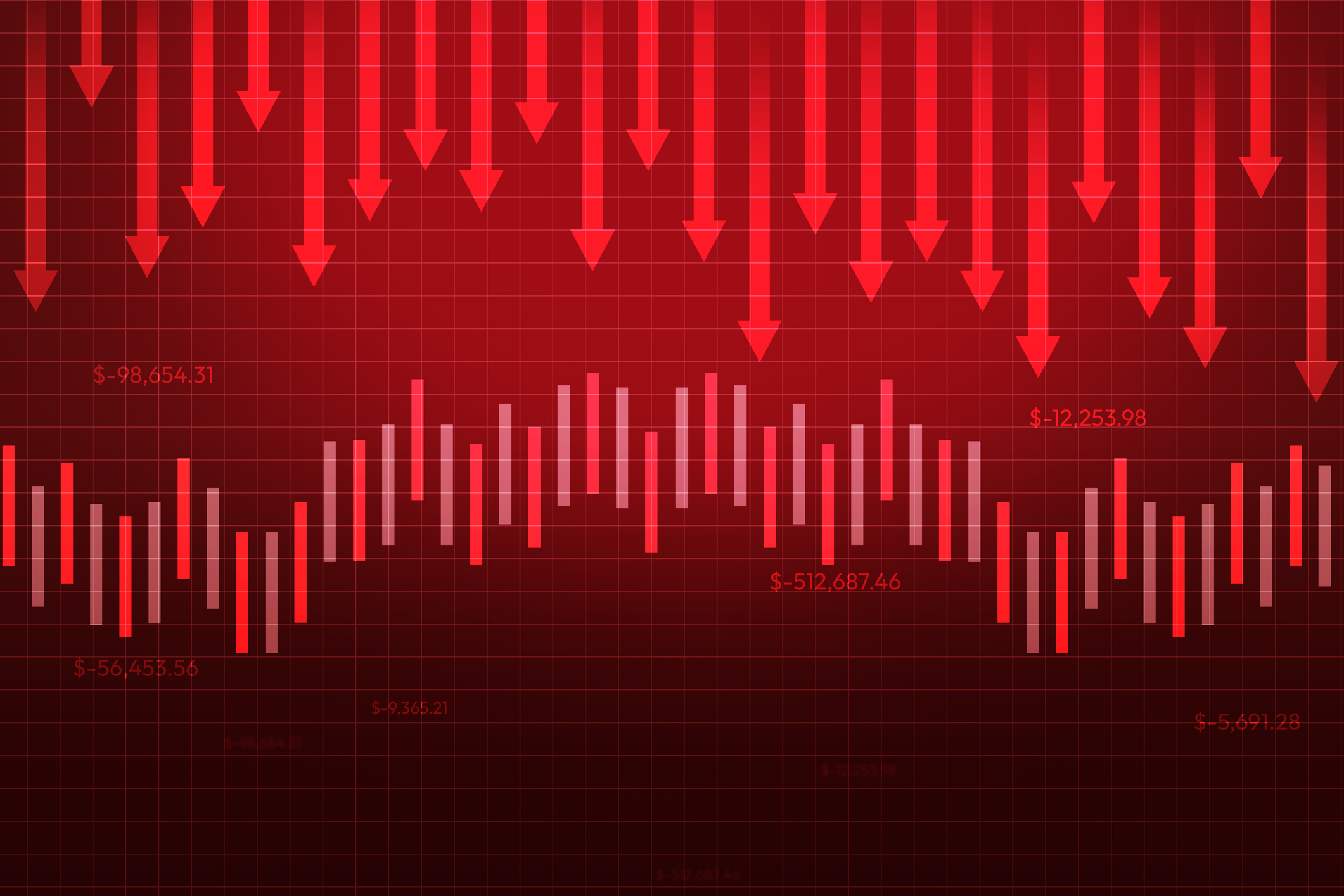Risk Is Off Again, Dow Falls 397 Points: Stock Market Today
Market participants are weighing still-solid earnings against both expectations and an increasingly opaque economic picture.


Investors pulled back their bets Thursday during another steep sell-off for stocks, as a fresh set of private-sector data indicated a weakening labor market. Consumer discretionary, technology and communication services – basically, all the "risk on" sectors – led the way lower as inevitable questions about current valuations and future cash flows re-took hold of the market's collective mind.
Amid the record-long government shutdown, data from employment agency Challenger, Gray & Christmas showed U.S. employers announced 153,074 job cuts in October. That's up 183% from the 54,064 cuts announced in September and 175% compared to October 2024. October layoffs hit their highest level since 2003, and hiring slowed to a 14-year low.
"October's pace of job cutting was much higher than average for the month," said CG&C Chief Revenue Officer and workplace expert Andy Challenger. "Some industries are correcting after the hiring boom of the pandemic, but this comes as AI adoption, softening consumer and corporate spending, and rising costs drive belt-tightening and hiring freezes."
From just $107.88 $24.99 for Kiplinger Personal Finance
Become a smarter, better informed investor. Subscribe from just $107.88 $24.99, plus get up to 4 Special Issues

Sign up for Kiplinger’s Free Newsletters
Profit and prosper with the best of expert advice on investing, taxes, retirement, personal finance and more - straight to your e-mail.
Profit and prosper with the best of expert advice - straight to your e-mail.
The agency said employers have announced 1.1 million job cuts year to date through October, up 65% vs the first 10 months of 2024 and 44% from the 761,358 cuts announced for the full year. Year-to-date job cuts are at the highest level since 2020, when 2.3 million cuts were announced through October.
Cleveland Fed President Beth Hammack said today that inflation is a bigger risk than a weak employment market. "After last week's meeting," Hammack said in remarks prepared for delivery at the Economic Club of New York, "I see monetary policy as barely restrictive, if at all. It's not obvious to me that monetary policy should do more at this time."
Chicago Fed President Austan Goolsbee told CNBC he's uneasy about cutting interest rates given the lack of inflation data during the shutdown.
Meanwhile, a looming Supreme Court decision on President Donald Trump's tariffs introduces another potential layer of uncertainty for global markets.
At the closing bell, blue-chip Dow Jones Industrial Average had fallen 0.8% to 46,913, the tech-heavy Nasdaq Composite was down 1.9% to 23,053, and the broad-based S&P 500 had shed 1.1% to 6,720.
Up and Down with Papa Dow
Many technical analysts will say the Dow Jones Industrial Average is still the most important stock market index in the world, and not just because it's one of the two oldest.
The Dow Industrials debuted on May 26, 1896, while the Dow Jones Transportation Average was originally published as the Dow Jones Railroad Average on July 3, 1884. What Dow Jones stocks do is cover many sectors without overloading any one or two or three in particular.
It only includes 30 names, but it is at least as diversified as the S&P 500 and is much more so than the Nasdaq-100, the underlying index for the widely held Invesco QQQ Trust (QQQ, -1.9%), the most famous but not necessarily the best Invesco ETF to buy.
The Dow is a price-weighted index, while the S&P 500, the Nasdaq Composite and the Nasdaq-100 are market-cap weighted indexes. According to Dow Jones and FactSet, a $1 move in one of its components translates into a 6.16-point move for the index.
Today, for example, the price of Salesforce (CRM) – one of the 10 best tech stocks of all time, by the way – fell $13.41, or 5.3%, and took an 82.6-point bite from the index.
Magnificent 7 bellwether Nvidia (NVDA) declined 3.7% from $195.21 to $188.08 and pulled 43.9 points from Papa Dow. Amazon.com (AMZN, -2.9%) and Microsoft (MSFT, -2.0%) also dragged on the index.
Modest gains for old-school large-cap stocks International Business Machines (IBM, +1.9%), Merck & Co. (MRK, +1.7%), Chevron (CVX, +0.2%), JPMorgan Chase (JPM, +0.6%) and Johnson & Johnson (JNJ, +0.6%) – representing tech, health care, energy, financials and consumer staples – weren't enough to offset the magnitude of CRM's and NVDA's losses.
What NRG can tell us
NRG Energy (NRG) looks like an energy stock and a utility stock, producing natural gas and coal and also generating and selling electricity. And it occupies a sweet spot with regard to rising demand for power to keep the AI revolution and data centers humming. Indeed, the stock was up more than 90% year to date vs a little more than 14% for the S&P 500 heading into this morning's third-quarter earnings announcement.
NRG reported earnings of $2.78 per share, up from $2.10 a year ago, and management reaffirmed the full-year EPS guidance it raised in September from $7.55 to $8.15. The board also authorized a $3 billion share repurchase program and an 8% dividend increase.
The power producer, which continues to benefit from surging electricity demand driven by data-center construction in Texas, expects 2026 core profit of $3.93 billion to $4.18 billion vs updated 2025 guidance of $3.88 billion to $4.03 billion.
"We see progress with NRG's strategic effort to capitalize on rising power demand," writes CFRA Research analyst Daniel Rich, who notes the company has signed 445 megawatts (MW) of new data-center agreements year to date, a 51% increase from the second quarter.
Despite the impressive results, NRG ended the day down 1.9% amid the broader selloff in all things AI.
How to be a trillionaire
Tesla (TSLA, -3.5%) recovered from its intraday lows but was down as much as 5.9% leading up to the company's annual meeting and a highly charged shareholder vote on a proposed $1 trillion pay package for CEO Elon Musk.
As Karee Venema notes, "The compensation comes with some fairly steep hurdles that the electric vehicle maker will need to surpass in order for Musk to collect, which could have big implications for the Magnificent 7 stock."
A key factor in the vote is the composition of TSLA's shareholder base – Elon Musk's constituency, if you will. According to data compiled by Bloomberg, retail investors own 41% of outstanding TSLA stock, while institutions such as mutual funds and exchange-traded funds hold 59%.
Retail investors own an average of about 25% of the other Mag 7 stocks. And they own an average of 5% of stocks in the S&P 500.
Related content
- 5 Dividend Growth ETFs to Buy
- A Broad Approach to Innovative Trends Helps This SPDR ETF Outperform
- Earnings Calendar and Analysis for This Week (November 3-7)
Profit and prosper with the best of Kiplinger's advice on investing, taxes, retirement, personal finance and much more. Delivered daily. Enter your email in the box and click Sign Me Up.

David Dittman is the former managing editor and chief investment strategist of Utility Forecaster, which was named one of "10 investment newsletters to read besides Buffett's" in 2015. A graduate of the University of California, San Diego, and the Villanova University School of Law, and a former stockbroker, David has been working in financial media for more than 20 years.
-
 I'm want to give my 3 grandkids $5K each for Christmas.
I'm want to give my 3 grandkids $5K each for Christmas.You're comfortably retired and want to give your grandkids a big Christmas check, but their parents are worried they might spend it all. We ask the pros for help.
-
 If You're Not Doing Roth Conversions, You Need to Read This
If You're Not Doing Roth Conversions, You Need to Read ThisRoth conversions and other Roth strategies can be complex, but don't dismiss these tax planning tools outright. They could really work for you and your heirs.
-
 Could Traditional Retirement Expectations Be Killing Us?
Could Traditional Retirement Expectations Be Killing Us?A retirement psychologist makes the case: A fulfilling retirement begins with a blueprint for living, rather than simply the accumulation of a large nest egg.
-
 I'm a Financial Planner: If You're Not Doing Roth Conversions, You Need to Read This
I'm a Financial Planner: If You're Not Doing Roth Conversions, You Need to Read ThisRoth conversions and other Roth strategies can be complex, but don't dismiss these tax planning tools outright. They could really work for you and your heirs.
-
 Could Traditional Retirement Expectations Be Killing Us? A Retirement Psychologist Makes the Case
Could Traditional Retirement Expectations Be Killing Us? A Retirement Psychologist Makes the CaseA retirement psychologist makes the case: A fulfilling retirement begins with a blueprint for living, rather than simply the accumulation of a large nest egg.
-
 I'm a Financial Adviser: This Is How You Can Adapt to Social Security Uncertainty
I'm a Financial Adviser: This Is How You Can Adapt to Social Security UncertaintyRather than letting the unknowns make you anxious, focus on building a flexible income strategy that can adapt to possible future Social Security changes.
-
 I'm a Financial Planner for Millionaires: Here's How to Give Your Kids Cash Gifts Without Triggering IRS Paperwork
I'm a Financial Planner for Millionaires: Here's How to Give Your Kids Cash Gifts Without Triggering IRS PaperworkMost people can gift large sums without paying tax or filing a return, especially by structuring gifts across two tax years or splitting gifts with a spouse.
-
 'Boomer Candy' Investments Might Seem Sweet, But They Can Have a Sour Aftertaste
'Boomer Candy' Investments Might Seem Sweet, But They Can Have a Sour AftertasteProducts such as index annuities, structured notes and buffered ETFs might seem appealing, but sometimes they can rob you of flexibility and trap your capital.
-
 AI Stocks Lead Nasdaq's 398-Point Nosedive: Stock Market Today
AI Stocks Lead Nasdaq's 398-Point Nosedive: Stock Market TodayThe major stock market indexes do not yet reflect the bullish tendencies of sector rotation and broadening participation.
-
 Got $100 to Gamble? These Penny Stocks Could Be Worth the Ride
Got $100 to Gamble? These Penny Stocks Could Be Worth the RideVolatile penny stocks are high-risk plays with potentially high rewards. If you have $100 you can afford to lose, these three names are worth a look.
-
 Quick Question: Are You Planning for a 20-Year Retirement or a 30-Year Retirement?
Quick Question: Are You Planning for a 20-Year Retirement or a 30-Year Retirement?You probably should be planning for a much longer retirement than you are. To avoid running out of retirement savings, you really need to make a plan.